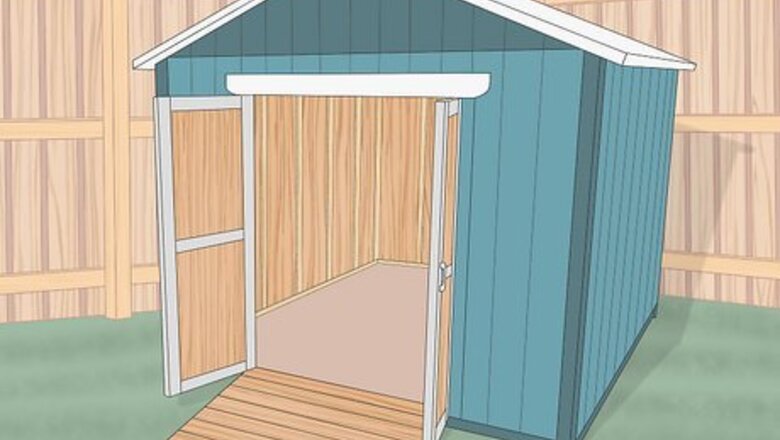
views
Preparing Your Shed
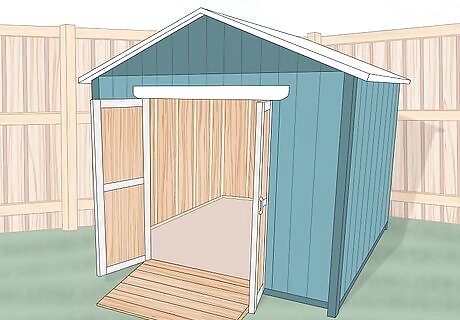
Empty your shed to check for damage to its structure and contents. Before you proceed with the organization of your shed, wait until a dry day and drag everything outside. Check the shed's structure carefully for any signs of damage and water entry.Organize a Messy Garden Shed Step 1Bullet1 Version 2.jpg Examine the contents you took outside carefully for any signs of water damage, as this may indicate a leak you can’t see.Organize a Messy Garden Shed Step 1Bullet2 Version 2.jpg Check for any pest attack, such as moth damage to any fabric stored in the shed.Organize a Messy Garden Shed Step 1Bullet3 Version 2.jpg Make sure that all chemicals are sealed, the containers are undamaged, and the labels are still legible. Repair any structural damage to the shed and give it a sweep out before you put everything back inside.Organize a Messy Garden Shed Step 1Bullet4 Version 2.jpg If it begins raining while your shed's contents are outdoors, throw a tarpaulin over the contents.Organize a Messy Garden Shed Step 1Bullet5 Version 2.jpg Also, remember that chemicals should never be left in hot or direct sunlight, and mustn’t be allowed to leak into the ground or water.Organize a Messy Garden Shed Step 1Bullet6 Version 2.jpg
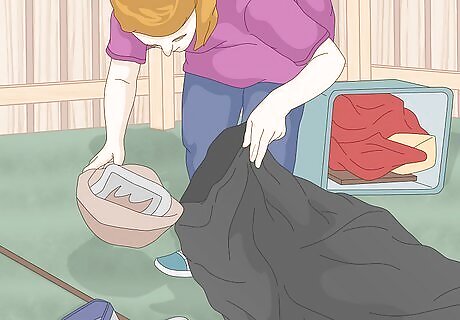
Throw out anything you don’t need to make space. You should sort through the contents of your shed and throw out anything that is unnecessary or past its usefulness. If you aren’t sure how to declutter, follow these simple rules: First, admit you aren’t going to get around to fixing any broken items. Then get rid of anything broken! Safely dispose of any chemicals that have passed their expiry dates. Get rid of anything you haven’t used for 2 years. If you are fortunate enough to have duplicates of useful items, celebrate your good luck by donating them to people less fortunate than you.
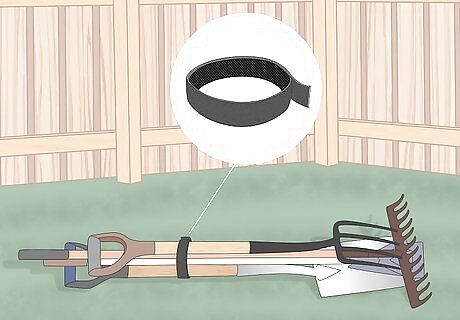
Gather up messy tools. Garden tools tend to come in all shapes and sizes, and so does the rest of the contents of many peoples’ sheds. Bundle some hook-and-loop fastener wrap around collections of garden canes or longer hand tools such as hoes and spades. This will hold them together.Organize a Messy Garden Shed Step 3Bullet1 Version 2.jpg Use tall boxes to store long tools that you rarely use.
Storing Things Efficiently
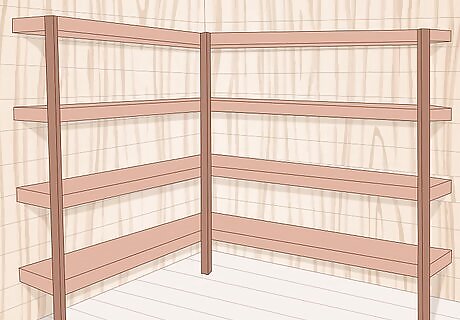
Raise things off the floor to improve your storage space. If you have a messy shed, it’s probably because you have limited storage options within the shed. Consider the following solutions to improve your storage and raise things off the floor of your shed: Install shelves.Organize a Messy Garden Shed Step 4Bullet1 Version 2.jpg Install pegboard.Organize a Messy Garden Shed Step 4Bullet2 Version 2.jpg Install tool hooks or hook-and-loop fastener tidy straps.Organize a Messy Garden Shed Step 4Bullet3 Version 2.jpg A cheap shoe tidy hung on the back of the shed door adds valuable storage for smaller items.Organize a Messy Garden Shed Step 4Bullet4 Version 2.jpg Consider hanging items from the ceiling. For example, overhead storage racks, hooks, bike pulleys or lifts, or even jelly jars attached by their lids to the ceiling offer increased storage.Organize a Messy Garden Shed Step 4Bullet5 Version 2.jpg Consider a fold-down workbench or get one with integrated storage cupboards underneath.
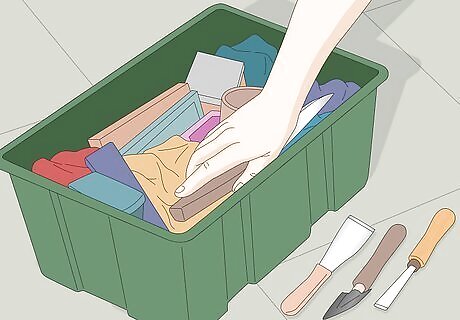
Store sharp hand tools in a rigid container. Consider using old ammunition boxes or stout wooden crates to store your sharp hand tools. You can also store them upright in a rigid plastic bin, such as an old dustbin. This will prevent any contact with the blade. It’s best if you don’t jumble bladed tools together to avoid blunting the edges.
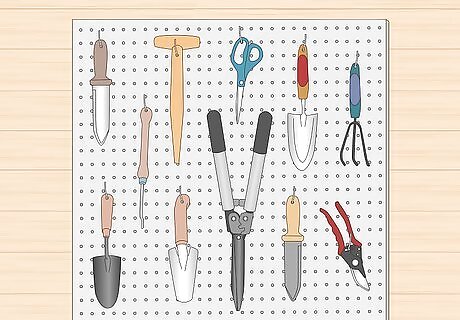
Modify your shed's walls to create tool storage space. There are a variety of ways, beyond shelves, to utilize the walls of your shed for storage. Consider these solutions: You can nail lengths of hook-and-loop fastener wrap to the shed wall and use these to attach your tools directly to the wall. Drive some hooks into the shed wall at a height just slightly above your knee. Take some bungee cords or ratchet straps with hooks on the end, hook them to the wall with fairly strong tension, and make elasticated wall storage that will hold your tools flat against the walls. Peg board is a terrific way to store items on walls. Get some hooks to hang your tools from the pegboard, and you can hang boxes from them for smaller items like screws.
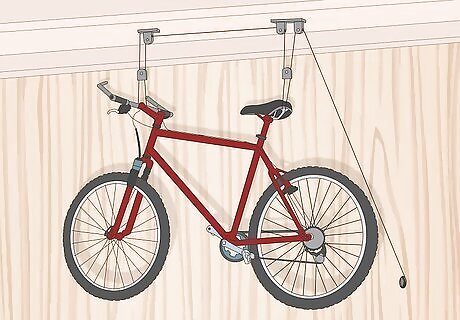
Take advantage of your shed's ceiling for storage. Don’t neglect to hang things from the roof. Here are some ideas for roof storage: Bikes can go on a bike rack or pulley system on the ceiling.Organize a Messy Garden Shed Step 7Bullet1 Version 2.jpg Ladders can also rest in a simple frame holder you can hang from the ceiling.Organize a Messy Garden Shed Step 7Bullet2 Version 2.jpg Also, consider hanging a length of rigid plastic pipe such as a water pipe length from the ceiling. You can slot long narrow items such as garden canes or lengths of dowling rod into this.
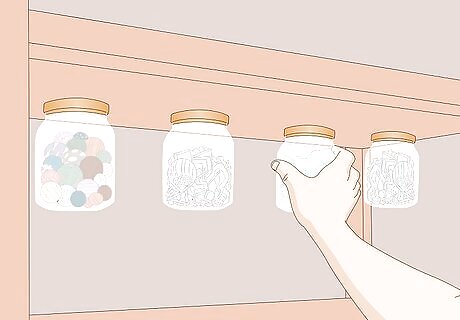
Use jars and cans to store miscellaneous items. Sheds are usually filled with all sorts of useful smaller objects that defy categorization, such as the fitting for a hose pipe, different sizes of screws, and tulip bulbs. One way to store smaller items is to glue the external lid of a jelly jar to the internal roof of your shed. Just reach up and unscrew the jar lid to access the contents.Organize a Messy Garden Shed Step 8Bullet1.jpg Avoid nailing through the roof as this will ruin the water seal. You can also nail or screw jars to the underside of shelves. Clear jars help you see what’s inside. Glue old cans or short sections of water pipe to the walls to make easy storage for small items like gardening gloves. Cut the spout and the top few inches off an old plastic milk jug. These make good storage for smaller items and have a carry handle.
Storing Chemicals
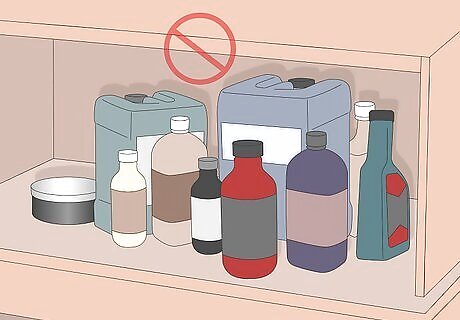
Understand the dangers of storing your chemicals in your shed. Perhaps you are storing chemicals in your shed such as weed killer, pesticides, or white spirits. You might also be storing petrol, diesel, oil or paints: all of these things are toxic. Some of these items are flammable; others like petrol can give off very noxious fumes, especially in a confined space like a shed. It’s very important that none of these chemicals are allowed to contaminate the water supply or the ground.
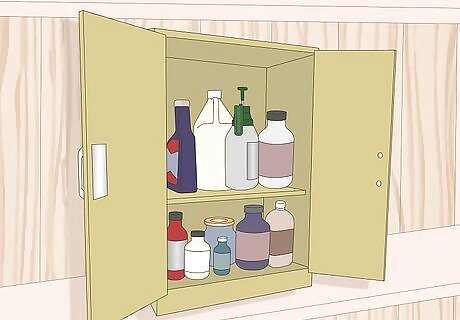
Store your chemicals properly to stay safe. If you have any of the aforementioned chemicals in your shed, you can take some steps to ensure that they are stored properly. Here’s some basic advice for storage of chemicals in your shed: Always keep chemicals in the original container. Store substances such as petrol in containers intended for that purpose. Petrol is corrosive and can wear away at containers not designed for storing petrol, leaking into water and ground and causing a hazard. Store chemicals out of reach of pets and children, in a cool dry place out of sunlight. Only buy as much as you need for the year. Chemicals in powder form should be stored away from, or above, liquids to stop drips and leaks that can cause chemical reactions. Avoid keeping chemicals past their expiry date. Dispose of chemicals safely and never down drains or into water.












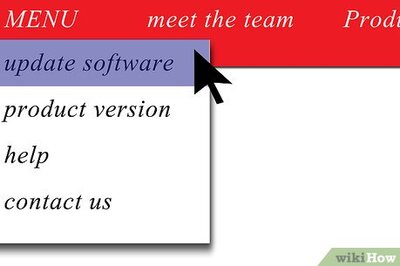




Comments
0 comment